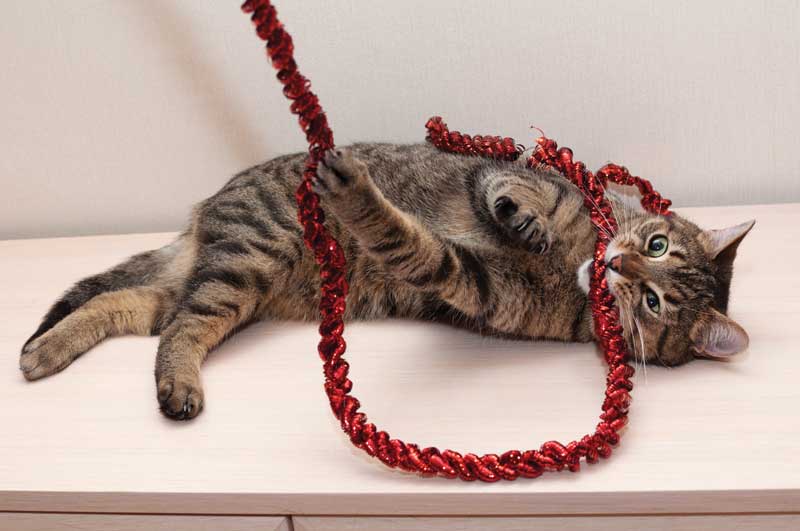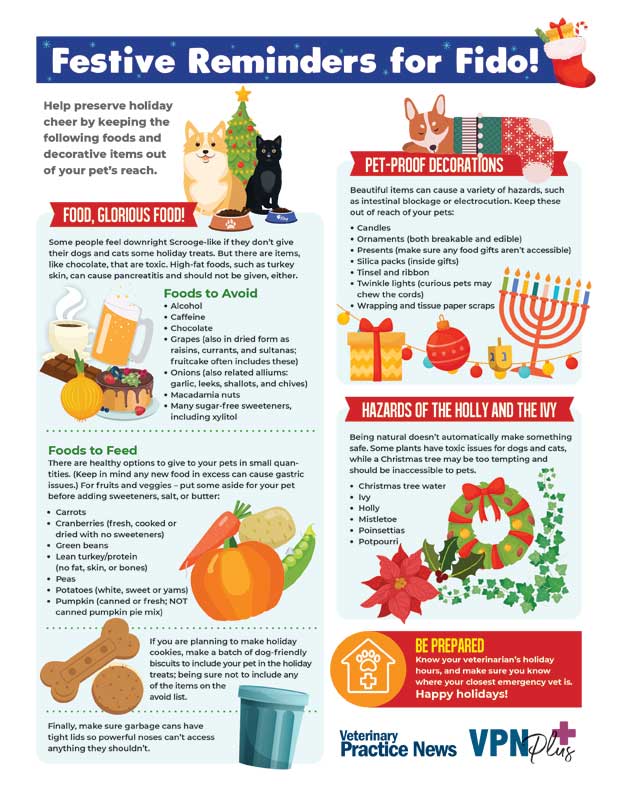
A rum-soaked fruitcake was behind Justine Lee, DVM, DACVECC, DABT’s most unusual case. The beagle that ate it—of course it was a beagle—was poisoned not only by the raisins the cake contained, but also by the alcohol in which it had been doused, leaving the dog comatose and breathing slowly. In other words, it was drunk and passed out.
Delicious holidays foods are just one of the seasonal pitfalls facing clients and their pets. Help them stay accident-free with hazard management and avoidance tips from emergency, critical care, and toxicology experts and practitioners. Here are the usual—and not-so-usual—suspects and what to tell clients about them.
Fearsome festive foods
Chocolate, turkey, and grapes are among the edible culprits that bring pets into the clinic or emergency room during the holiday season.
Emily M. Tincher, DVM, senior director, pet health for Nationwide, says 2022 statistics show that 20 percent of the pet health insurance company’s annual chocolate toxicity claims come in the month of December, with chocolate toxicity claims doubling in the last two weeks of that month.
“When we see chocolate poisoning, most of the time it’s with dogs, not cats,” says Dr. Lee, who is double boarded in emergency critical care and toxicology. However, downing a couple of mini candy bars or chocolate-chip cookies might just cause mild vomiting or diarrhea, depending on the size of the dog.
Severe toxicity is unusual except in large quantities or if the dog has ingested dark chocolate or chocolate meant for baking, which is higher in theobromine, the primary toxin in the sweet stuff.
“In general, it takes about a pound of chocolate per 40 pounds of body weight for milk chocolate to be an issue,” says emergency critical care specialist Tony Johnson, DVM. Smaller dogs that eat large amounts of chocolate are at greater risk because less chocolate is required to reach toxic levels.
It is also a concern if a dog eats not only a large amount of chocolate, but also gobbles down the wrappers, which can act as a potential foreign body in the stomach, Lee says.
Grapes can cause acute anuric renal failure in dogs, Dr. Johnson says. Until recently, though, the toxic component in grapes and raisins was unknown, as was the toxic amount. Based on a study published in the Journal of Veterinary Emergency Critical Care,1 the problematic ingredient in grapes appears to be tartaric acid, to which dogs are uniquely sensitive.
In an interview with Andy Roark, DVM, on “Cone of Shame Veterinary Podcast,” Tina Wismer, DABVT, DABT, medical director of the American Society for the Prevention of Cruelty to Animals (ASPCA) Animal Poison Control Center, puts the probable toxicity dose for grapes and raisins at more than one raisin or grape for every 10 pounds.2
It is still an erratic, unpredictable toxin, Johnson says, but if a client’s 60-lb dog eats two grapes, you can probably put their mind at ease.
Few clients can resist giving pets a taste of a holiday meal—a helping of turkey, stuffing that may contain onions, and buttery, creamy mashed potatoes, for instance. The fatty meal, even in small amounts, can lead to mild vomiting and diarrhea at best and acute necrotizing pancreatitis at worst.
“When pet owners are giving scraps of turkey, we can often see a massive spike in pancreatitis,” Lee says. With mild gastrointestinal upset, pets may need subcutaneous fluids or an injection of an anti-vomiting medication, while others require hospitalization to manage the inflammation in their gastrointestinal tract. Lee cautions owners not to give any table scraps, especially if they live with breeds predisposed to pancreatitis, which include Shetland sheepdogs, miniature schnauzers, and Yorkshire terriers, as well as overweight dogs or those with other medical problems.
Linear foreign bodies
Tinsel, ribbons, the string tied ’round the turkey: all are hazardous to pets that ingest them—especially cats, with their spiky tongues that latch onto stringy items and do not let go.
“For cats with suspected linear foreign bodies, when I start to see a bunch of teardrop-shaped bubbles on radiographs, to me that sometimes correlates with plication and bunching of the intestines,” Johnson says. “If I see more than two or three teardrop-shaped gas bubbles, that ups my level of alarm a little bit.”
When there is a high suspicion of a linear foreign body, confirm with ultrasound or exploratory surgery if ultrasound is not available. “One thing with linear foreign bodies is always remember to look under the tongue of a cat,” he says. “They can get a piece of string or dental floss that hooks under the base of the tongue and then goes down into the intestines and gets bunched up. So that can help you confirm. And if you cut it from under the tongue, it can help you manage it in surgery.”

Human medications and other drugs
For people, holidays and hangovers often go hand in hand—and sometimes shaky hands drop nonsteroidal anti-inflammatory drugs (NSAIDs) on the floor, unnoticed, where curious pets can scarf them up.
Standard practice for NSAID ingestion is to recommend IV fluids for 48 hours, which can cost clients $2,000 to $3,000, depending on where you practice. However, Johnson says presentations at the 29th International Veterinary Emergency & Critical Care Symposium (IVECCS) in Colorado suggested that is not always necessary.
“I have yet to see numbers on this, but what I’ve heard is as long as the pet is stable, has no GI signs, has normal kidney values on initial lab work, you can just manage them at home with gastro protectants, close monitoring, and maybe checking their kidney values a time or two rather than putting them in the hospital,” says Johnson.
Pets may also be more likely to ingest antidepressants and recreational drugs during the holidays. Some states have legalized marijuana, tetrahydrocannabinol (THC) products, and hallucinogenic mushrooms.
“Those products are so much more readily available now that if an owner thinks their dog got into a chocolate bar, we’ve got to ask, ‘Was there marijuana or THC in there?’” says Renee Schmid, DVM, DABVT, senior veterinary toxicologist at Pet Poison Helpline.
Decorations
Lilies, liquid and dried potpourri, scent diffusers, and burning candles are all potential pet hazards; while poinsettias, holly, and mistletoe are less of a concern, which may surprise some clients. Dr. Tincher says Nationwide’s average claim for plant poisoning is $610 and for burns $180.
Essential oils pose a hazard to cats, birds, senior dogs, and pets with breathing problems, including brachycephalic breeds like French bulldogs or pugs, Tincher says.
“This is one health hazard that many pet parents are still not aware of, so being proactive in offering caution and targeted education about diffusers can help your clients avoid emergencies,” she adds.
Advise owners who want to use diffusers to limit them to large, well-ventilated rooms.
Pets that ingest essential oils may develop oral irritation, ulcers, or chemical burns, as well as fever, difficulty breathing, and tremors. Pets with respiratory issues, such as asthma or chronic bronchitis, can be particularly sensitive to airborne scents.
Owners may see an increase in breathing rate, coughing or irritation. Birds are especially vulnerable to scented candles, ionizing air filters, cigarette smoke, and fumes from overheated Teflon pans.
In addition to hazards, offer advice on helping pets stay calm and comfortable during holidays since the addition of menorahs, Christmas trees, and other holiday décor may confuse them. “The changes can stress dogs and cats into abnormal behaviors, so doing slow changes and using calming treats, collars or medications over the holidays can be beneficial,” says Grant Little, DVM, a small-animal veterinarian in Nebraska.
Vacation care
People may leave pets in the care of others during the holidays and it is important to make sure the pet’s routine remains the same, says Stephen J. Divers, BVetMed, DZooMed, Dip. ECZM, DACZM, FRCVS, a professor at the University of Georgia College of Veterinary Medicine and treats reptiles, birds, small mammals, and fish. “If there’s a change in caretaker, there can be a change in management,” Dr. Divers says. “If a rabbit is being fed certain foods in the morning and the person taking over feeds different foods at different times of day, that can cause a herbivore to have gastrointestinal stasis. That can be very serious and sometimes fatal.”
He advises clients to leave explicit instructions regarding what, when and how much to feed so that management is as consistent as possible.
Clients may feel comfortable leaving reptiles, such as snakes, on their own for a few days because the animal is fed or cleaned only once a week. However, Dr. Divers notes a power failure can cause heat lamps to malfunction, exposing reptiles to low temperatures, which can be especially problematic for tropical species during cold weather. The opposite situation—excessive heat from a malfunctioning heater or hot rock—can be more dangerous, causing burns and acute fatality, he says. It is always a good idea for clients to have someone check on them just in case.
Get the word out
Social media is your best friend when it comes to alerting clients to holiday hazards. Text reminders, emails, and newsletters are also great methods to share seasonal health tips, especially if you do not have time for such conversations in the exam room, Tincher says. (See Holiday Hazards Infographic.)
Appeal to clients’ wallets. Tincher notes that the average claim for chocolate toxicity is $618; for alcohol toxicity, $869; and foreign body ingestion, $2,400. Being aware of these potential budget hits may help clients be more cautious during holidays.
Make sure the information you provide is from a credible source, such as an animal poison control center, a veterinary school, or a medical association.
Lee has seen erroneous medical information on veterinary websites for pet owners, on how to induce vomiting, for instance. “In dogs, we only ever recommend three percent hydrogen peroxide. Once in a while, I’ll see on a vet’s website that peroxide can be used in cats, and it can’t. That is very dangerous,” she says.
Provide clients with contact information for pet poison hotlines and the nearest veterinary emergency clinics. Refrigerator magnets are a good way to do this or advise clients to program their phones with phone numbers for emergency veterinarians and poison control.
“That way they can call immediately for life-saving advice and be sure they know upfront that there is a fee for poison control consultation,” Lee says.

Kim Campbell Thornton has been writing about dogs, cats, wildlife, and marine life since 1985, and is a recipient of multiple awards for her articles and books from the Cat Writers Association, Dog Writers Association of America, and American Society of Journalists and Authors.
References
- Wegenast CA, Meadows ID, Anderson RE, Southard T, González Barrientos CR, Wismer TA. Acute kidney injury in dogs following ingestion of cream of tartar and tamarinds and the connection to tartaric acid as the proposed toxic principle in grapes and raisins. J Vet Emerg Crit Care (San Antonio). 2022 Nov;32(6):812-816. doi: 10.1111/vec.13234. Epub 2022 Jul 23. PMID: 35869755.
- Cone of Shame Veterinary Podcast, Surprise Summer Toxins You’re Not Ready For, Andy Roark, DVM, MS, interviewing Tina Wismer, DVM, DABVT, DABT
